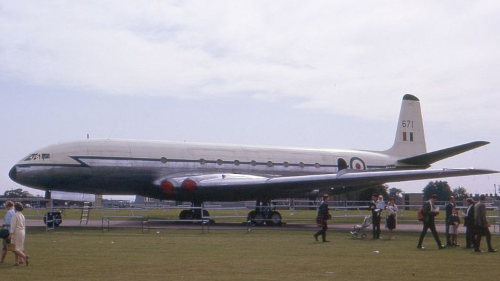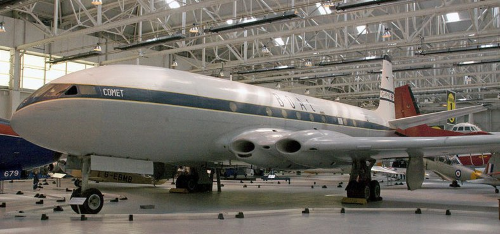Back in 1929, a Royal Air Force officer by the name of Frank Whittle had the idea to develop an airplane with a gas turbine engine.
During that time, aircraft used a propeller to move forward.
This new proposal suggested having exhaust gases forced out of the engine to propel the airplane forward.
According to Whittle, it worked “like a giant vacuum cleaner; it sucks air at the front and blows it out the back.”
Britain’s first fighter jet, the Gloster Meteor, was created after an extensive eleven years of experiments and research.
Related Article – Airline Transport Pilot Certificate (ATP): 4 Things You Need To Know
There was only one manufacturer who had the capability of producing both jet engines and aircraft after World War II, the Vampire fighter by de Havilland.
Soon after, the de Havilland Comet became the first commercial jetliner, and it set Great Britain up to be one of the most influential nations in the development of commercial aviation.

It didn’t take long for the Comet to gain popularity in a time when trains and ships were still the major means of transportation.
In 1952, air travel was not yet widespread.
There were not many developments in commercial aviation between the late 1930s and the 1950s, due to World War II causing a temporary halt to the experimentation of aircraft.
The Douglas DC-7C, which was the first plane to provide non-stop transatlantic service, used the same design for more than 15 years.
It was quite an uncomfortable plane with 3,400 horsepower engines, each equipped with 72 cylinders, which caused it to be loud and vibrate a lot.
Because of all of this, the de Havilland Comment stirred up a lot of interest when it was introduced in 1952.
Related Article – 12 Runway Markings and Signs Explained By An Actual Pilot
The four jet engines were located inside the wings, so people didn’t see an obvious means of propulsion. It sounded different as well, and it was faster.
The flight to Johannesburg, South Africa was normally 40 hours, but the Comet completed it in 23 hours, with speeds up to 500 MPH and going through Rome, Beirut and Khartoum.
The Comet also flew above the storms and bad weather, up to eight miles above the stratosphere.
The fully pressurized cabin was much more comfortable, and the plane ride was quiet and smooth, something that had yet to be seen in commercial aviation.
Two accidents occurred in 1953, both happening on takeoff.
The plane was not able to go airborne in the first accident; it was due to pilot error, and there were no fatalities.
The second accident was much more severe, and it resulted in no survivors.
It was said to be caused by a design flaw in the aircraft, and a modification afterward allowed for a greater lift at low speeds.
There was a third accident, blamed on turbulence and not the plane, that occurred when the Comet was attempting a takeoff from Calcutta.
Despite these accidents, the public’s unwavering confidence in the Comet remained until January 10, 1954.
It was on that date when a BOAC Comet departed from Rome and climbed to 26,000 feet and attempted to reach 36,000 feet.
While Captain Alan Gibson was taking the plane to its assigned altitude, he heard another BOAC plane that was behind him send a radio message.
The message wasn’t clear, and moments later remains of the Comet fell into the ocean close to the island of Elba.
As de Havilland and the British government searched for the cause of the crash, the rest of the Comets were grounded.
It proved impossible to get a clear answer due to the thousands of pieces that fell hundreds of feet beneath water.
Related Article – 14 Taxiway Markings, Signs, and Lights Explained By An Actual Pilot
There was speculation of sabotage, turbulence, and an explosion in an empty fuel tank.
The Royal Navy continued to investigate using sonar, divers, and underwater cameras, and they came up with 50 recommended modifications for the remaining planes.
While they didn’t know for sure, they hoped that the changes would fix whatever problem had caused the Comet to crash.
Some of those modifications included installing shields between engines and fuel tanks, new and improved smoke detectors, and reinforced fuel lines.
After about two months, the planes were back up in the sky, but another BOAC Comet disappeared just two weeks later.
The aircraft left Rome and was travelling to Cairo.
As it climbed to 35,000 feet, the radio contact failed once again.
Nobody saw what happened, and the Comets were grounded for a second time.
The Royal Navy made some progress on the first accident after they discovered and salvaged around two-thirds of the Comet.
They believed the cabin failed, and there were traces of blue on the tail of the aircraft.
After Chemical Analysis was conducted, they determined that the blue came from the seats in the cabin.
In addition to that, they found fuselage on the left wing.
It was concluded that the cause of the crash was due to explosive decompression of the cabin.
There were many questions surrounding the reasons behind the crash; the Comet was the most highly tested passenger plane ever constructed.
The engineers at de Havilland built a decompression chamber capable of withstanding unprecedented changes in pressurization.
Their previous testing included simulating conditions at 38,000 feet, and one of the test cabins passed 2,000 times.
Because of the success of the tests, the engineers were stumped as to how the accident happened.
In trying to find the cause, the Ministry of Civil Aviation built a large tank that held one of the grounded Comets.
There were slots in the sides of the tank where the wings fit, and they then filled the tank and cabin with water.
They raised the pressure inside the cabin to simulate the pressure a Comet encountered at 35,000 feet, and it was held for three minutes.
As the pressure was lowered, the engineers moved the wings up and down with the use of hydraulic jacks.
Related Article – 5 Best Low Time Pilot Jobs With 250 Hours
They continued this for 24 hours a day until the cabin reached stresses that equaled 9,000 flight hours.
After the test was completed, the investigators found a split in the fuselage that ended up reaching eight feet.
They determined that it was due to metal fatigue, and the water was the only thing that prevented the aircraft’s cabin from exploding.
It was determined that the major design flaw in the Comet was the square windows, which was acknowledged by the U.S. Civil Aeronautics Administration, later becoming the FAA, many years earlier.
This was the reason that the Comet was not granted an air-worthiness certificate, making it ineligible to fly in the U.S.
It was also a problem that de Havilland did not conduct adequate testing of the aircraft while it was in its design phase.
The new cabin only went under static testing, so the effects of motion were never studied.
The jet-powered Comet was revolutionary, so many did not know what to look for in an aircraft that climbed such high altitude so quickly.
Four years went by until the Comet was re-engineered and ready to fly again, but the Boeing 707 was already in service carrying twice as many passengers.
It had a greater range, and it was one of the most successful airliners ever created.
As more places bought up the 707s, the Comet faded away.
Related Article – Instrument Proficiency Check (IPC): 4 Things You Need To Know

